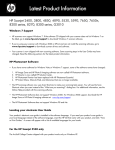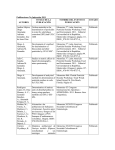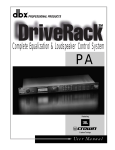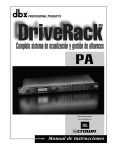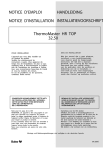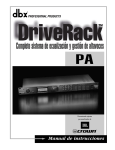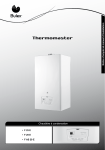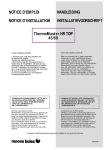Download EONSUB-G2 User Guide
Transcript
EONSUB-G2 User Guide Part Number: 981-00059-01 About the EON SUB G2 Applications To supplement or extend the low frequency output of powered and non-powered full-range speaker systems. Features • 15” Differential Drive™ low-frequency driver with dual neodymium magnet for high power handling, efficiency, and light weight. • 250 watts actual power delivered to the drivers. • Balanced loop-through output. • Thermomaster™ Total Thermal Management System®. A single piece, cast-aluminum baffle integrates the woofer frame, horn, and amplifier heat-sink. Air movement in the finned ports dissipates heat – no internal or external cooling fans are required. • Rugged, light weight, black co-polymer enclosure with cast aluminum baffle. • Integral 35 mm pole mount receptacle with securing thumb screw. • Extended low-frequency performance. Delivers powerful bass down to 40 Hz. Technical Specifications Freq. Range (-10 dB) Crossover Freq. Maximum SPL Dimensions (H x W x D) Net Weight Driver 40 Hz – 200 Hz 125 Hz 117 dB, @ 1 m (3.3 ft) 686 mm x 430 mm x 444 mm (27 in x 17 in x 17.5 in.) 19.5 kg (43 lbs.) Integral frame with one 15” (380 mm) driver, dual neodymium magnet, 2” differential drive voice coil. Electronic Amplifier Rated Power Input Type Maximum Input Level Line Level In Speaker Level In Input Impedance Line Level In Speaker Level In Audio Connectors Line Level In Speaker Level In Loop Output Low Pass Filter AC Input 250 watts @ 2ohms, 0.1% THD Balanced, differential +28 dBu 120 VRMS, speaker level 16 ohms line level 143 ohms speaker level XLR/F, balanced, line level 1/4” Phone, speaker level XLR/M, balanced, line level 125 Hz Active, 3-pole 110 – 230 VAC, selectable, 50 – 60 Hz, 203 watts rating per UL, detachable IEC power cable. Available Accessories SS2-BK ESK15 BRK15 EON15 BAG-1 EON15 BAG/W-1 6 Tripod Stand Suspension Kit for EON 15” models (except EON1500) Bracket, adapts EON 15” models to OmniMount® brackets Zippered, plush-lined speaker bag with wheels for EON15” models Zippered, plush-lined speaker bag for EON15” models Controls and Connections The audio section of the EON Sub G2 includes powerful features that enhance the flexibility of your subwoofer. Connectors LINE LEVEL INPUT I N P U T This balanced input accepts a standard XLR (female) connector. The LINE LEVEL INPUT is where the line level output of the audio mixer will be connected. LOOP THRU OUTPUT This XLR (male) connector is in parallel with the LINE LEVEL input and provides a convenient way to loop the audio signal from your mixer into additional EON Subs or your powered mid / high speakers. SPEAKER LEVEL INPUT LINE LEVEL LOOP THRU O U T P U T This 1/4” phone jack accepts the high level output from a power amplifier or powered mixer. The SPEAKER LEVEL INPUT is the easiest way to add the EON Sub G2 to an existing system using a powered mixer or external amplifier to drive mid / high speakers. See “EON Sub G2 with Powered Mixer and Passive Mid / High System” for more details. Switches and Controls POLARITY The performance of a subwoofer depends on how it interacts with the mid/high speaker system. Depending on characteristics of the mid/high system and the relative position of the subwoofer, changing this switch may improve system performance. Depress this switch to reverse the polarity of the subwoofer. PEAK VOLUME VOLUME The VOLUME control adjusts the input sensitivity of the EON Sub G2. Indicators POLARITY Rev Norm SIGNAL SPEAKER LEVEL IN PEAK This red LED illuminates to indicate that the amplifier output is approaching clipping. POLARITY REV This LED illuminates to indicate that the subwoofer is operating with reversed polarity. This means that a positive voltage on pin 2 of the LINE LEVEL INPUT will cause the speaker cone to move inward/backward. SIGNAL The SIGNAL LED illuminates to indicate that an audio signal is present at the LINE LEVEL INPUT or the SPEAKER LEVEL INPUT. 7 Block Diagram LOOP THRU OUTPUT SIGNAL POLARITY NORMAL REV LINE LEVEL INPUT PEAK REV EQ HPF LPF 250W VOLUME SPEAKER LEVEL INPUT About Subwoofers Here are a few bass basics. The ear is far less sensitive to very low frequencies than it is to midrange frequencies. A 1,000 Hz sound at 95 dB SPL may seem obnoxious and painful to the ear while 50 Hz. at 95 dB SPL will seem pleasantly powerful. Musicians, composers, and producers know this instinctively and create music that contains a great deal of energy below 100 Hz. In order to properly produce or reproduce this music, an audio system needs to be capable of delivering much more acoustic output at low frequencies than in the mid band. Note that the capability of delivering more output should not be confused with the characteristic of low-frequency equalization boost. A system that is equalized to be perfectly flat may require as much as 20 dB more maximum SPL capability in the low bass. This is because the requirement for the extra energy is already built into the music. And contemporary dance music may rely even more on low frequencies for its power and energy. To meet this need, speaker designers developed specialized speakers called subwoofers. Subwoofers are intended to work below 150 Hz. In fact, most subwoofers will sound downright bad if you try to use them to reproduce sound above 200 Hz. There are even sub-species of subwoofers. Some subwoofers are designed for extreme low–frequency extension and will go down as low as 20 Hz. This type of performance is usually more useful for cinema effects than for music. A sub that goes down this low will be very large and probably require a lot of amplifier power. Another variety of subwoofer that may be more appropriate and practical for portable music applications concentrates on delivering “punch”. Punch is what you experience when the kick drum hits you in the chest. Much of what we think of as punch is in the 80 Hz. region. Until recently, adding a subwoofer to a system was a complicated matter that required external crossover networks, extra power amplifiers, and of course the subwoofer itself. The EON Sub G2 simplifies this task by combining all this into a single, simple and light weight system. 8 Application Examples Stereo System With EON Mid / High System with EON Sub G2s This is a system in which a pair of EON Subs are used with a pair of EON 2-way powered speakers. MIX MIX LOOP LOOP O U T P U T O U T P U T 1 1 I N P U T I N P U T 2&3 2&3 2 3 2 3 MIC LINE MIC 1 LINE 1 R-PEAK R-PEAK G-SIGNAL G-SIGNAL 2&3 2&3 EON10-G2 EON10-G2 I N P U T LINE LEVEL LOOP THRU I N P U T LINE LEVEL LOOP THRU O U T P U T PEAK O U T P U T PEAK VOLUME POLARITY VOLUME POLARITY Rev Rev Norm SIGNAL SPEAKER LEVEL IN EON SUB Norm SIGNAL SPEAKER LEVEL IN EON SUB 9 Mono Subwoofer Here’s a slightly more advanced set-up in which the subwoofers are not driven from the same mixer output as the 2-way main speakers. Using the subwoofers in mono will not degrade the stereo image because the ear does not do a good job of determining the source location of low frequency sound. The illustration shows two ways of using EON subs in mono. While two subwoofers are shown, you can also use this technique with a single subwoofer. Driving the Subs from a Mono Output Many mixers have a mono output that sums the left and right mix. The advantage of using this output to drive your subwoofers is that you will have separate control over subwoofer volume from the mixing console. This allows you to easily vary the balance between subwoofers and mid/high speakers. Driving the Subs from an Auxiliary Output Many professional engineers will create a separate mix for subwoofers from the Auxiliary buss of the mixer. This technique can improve low-frequency system performance in a number of ways. The system operator has independent control of the overall balance between subs and mid/highs and more flexibility in adjusting the blend of low frequency instruments. Let’s say that you want to hear more lows from a bass guitar but don’t want to hear more overall bass guitar. This method allows you to bring up the bass guitar in the subs without effecting the main mix. Wind noise, handling noise, and bleed through of instrument amplifiers in a vocal mike can degrade the low-frequency sound. By using this technique, sources such as vocal mikes that don’t have desirable low-frequency content can be kept out of the subs. Send only the instruments (kick drum, bass guitar, etc.) that actually have low-frequencies to your subs. MIX LOOP MIX LOOP O U T P U T O U T P U T 1 1 I N P U T I N P U T 2&3 2&3 2 3 MIC LINE 2 3 MIC 1 R-PEAK LINE 1 R-PEAK G-SIGNAL G-SIGNAL 2&3 2&3 EON10-G2 EON10-G2 or EONSUB-G2 Option 1 Option 2 EONSUB-G2 Mixing Board 10 Powered Sub with Passive Mid / High The SPEAKER LEVEL INPUT on your EON Sub G2 provides a simple and convenient way to add subwoofers to a system with passive 2-way speakers. IN IN THRU THRU Passive 2-way Speaker Passive 2-way Speaker EONSUB-G2 EONSUB-G2 From Powered Mixer or Amplifier Outputs 11 Voltage Selection And Fuses Changing Voltage Your EON Sub G2 will typically be set at the factory to accommodate the power mains voltage in your area. Before you set up your EON Sub G2 for the first time it is a good idea to verify that the setting of the selector is appropriate for the power in your area. Directly below the IEC power connector you will see a seal that indicates the factory setting for the voltage. If the voltage indicated is correct for your area, go ahead and power up your EON Sub G2. In the event that you do need to change the voltage: • Make sure that the AC is disconnected from the speaker. • Directly below the male IEC connector on the speaker is a voltage selector. Break the factoryapplied seal. • Set the voltage selector switch to the 115V or 230V setting as required for your area. • After having reconfirmed that the correct voltage is selected, connect the AC (IEC connector) and power the unit up. DO NOT UNDER ANY CIRCUMSTANCES OPERATE THE UNIT WITH THE WRONG VOLTAGE SELECTED. DOING SO MAY RESULT IN SERIOUS DAMAGE TO YOUR SPEAKER SYSTEM WHICH WILL NOT BE COVERED BY WARRANTY. Fuse Replacement The EON Sub G2 has no user-serviceable fuses. Failure of fuses is most frequently a symptom of problems requiring service by a competent technician. Troubleshooting Symptom No sound Likely Cause Speaker not connected to active AC power. Power not switched on. No sound, speaker is connected to working AC power but won’t come on. Speaker power cable is faulty or improperly connected. Blown fuse. No sound. Speaker comes on. SIGNAL LED does not illuminate. Signal source (mixer, instrument, etc.) is not sending. Faulty cables and connections. Signal sounds distorted and very loud, PEAK light is lit most of the time. 12 Excessive input signal, trying to exceed the capabilities of the speakers. What to do Verify that speaker is connected and that the circuit is on. Switch on power and verify that power LED is on. • Re-seat the power cable at both ends. • Substitute a known-good power cable. • There are no user-serviceable fuses in the EON SUB G2. Take your speaker to a competent servicer. • Check VU meters on the source mixer. • Verify that the tape or CD is playing. • Use headphones to verify that the instrument is actually sending an audio signal. • Disconnect and re-seat signal cables. • Replace suspected cable with a known-good cable. • Reduce the output level of the source. • Turn down the LEVEL controls on the speaker. • Use additional EON speakers. Signal sounds distorted even at moderate volumes, PEAK light is not lit. Hum or Buzz that increases or decreases when the mixer level controls are moved. Mixer or other source is overdriven Improper A/C ground or faulty equipment connected to mixer input Faulty cable between source equipment and mixer Hum or Buzz Improper A/C grounding, ground loops Excessively long unbalanced cable run Improper system gain structure Speakers feedback and howl when the microphone volume is turned up Microphones are pointed into the speakers Equalizer settings are incorrect Excessive gain Review the Owner’s Manual for your mixer and adjust controls as needed • Input sensitivity (gain) • Channel faders • Master faders Disconnect or mute channels one at a time to isolate the problem. Refer to the owner’s manual of the faulty equipment for troubleshooting help. Substitute a known-good cable for the suspected faulty cable. • Connect all speakers to a common power circuit. • “Telescope” the audio ground by using an XLR/F to XLR/M adapter with Pin1 disconnected on one end. • Re-route audio cables away from AC power and lighting cables. • Use the balanced outputs (if available) of your mixer or source equipment to drive your EON speakers. • Use a “DI” (direct injection) box to convert your unbalanced equipment output to a balanced output. Reduce the INPUT 1, LINE 2, and LINE 3 controls and increase the output level of your source devices. Move the speakers so they do not point into the microphone’s pick-up pattern. Locate the feedback fre quency and reduce it using the mixer EQ or an external equalizer. Reduce the gain at the mixer and move the microphone closer to the sound source. 13










